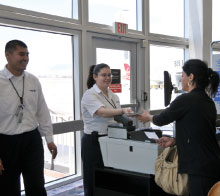
CUPPS is a great example of true industry collaboration. Having started in 2003 at the Seattle Summit, attended by airport, airline and vendor CEOs, the idea to update the old CUTE RP1797 was put into action. By October 2004 the CUPPS Recommended Practice was approved and intense work got underway to develop the CUPPS Technical Standard. The working groups were led by all stakeholders and the result is a solution designed by the industry, for the industry, and adopted as Recommended Practice by IATA, ATA and ACI.
The CUPPS achievement is an example of the industry working together in a collaborative effort to produce a common solution that meets the needs of airlines, airports and passengers alike.

The CUPPS technology is expected to provide significant savings to airports and airlines by introducing a uniform electronic interface for passenger applications. Airlines from all over the world have been active participants in the development of the CUPPS standard to ensure that it responds to their needs.
The CUPPS trial phase involved five Pilots: Las Vegas McCarran with ARINC the vendor partner, Orlando (SITA), Sacramento (AirIT), Dublin (Ultra Electronics) and Brussels (RESA). Samuel Ingalls, assistant director of aviation, information systems, Las Vegas McCarran International Airport and Chair of the CUPPS Leadership Team, explained that the platform vendors, air carriers and airports were very pleased with the results. Most importantly, the applications were proven to be portable among the vendors, which is chief as a value proposition for CUPPS.
SITA was the first platform provider to be certified as compliant with CUPPS version 1.01 since IATA published the Technical Specification. “SITA has invested in shared use services and will continue to dedicate resources to keep CUPPS updated and ensure that its solution, AirportConnect, meets the needs of its customers,” explained Catherine Mayer, Vice President, Airport Services for SITA. “SITA is proud to be first to receive CUPPS certification but also to become the first Certification Test Entity (CTE). Furthermore, SITA remains the only provider to date that has included a PCI solution in its platform, knowing that the regulation is impacting many of the airports and airlines around the world.”
When ARINC carried out the world’s first live test of CUPPS at Las Vegas McCarran Airport in January 2009 it was the culmination of many years’ work on developing a replacement for CUTE.
Not only was the test a resounding success, but the ARINC CUPPS platform has been running error-free ever since – and has been expanded to include gate operations for passenger boarding. ARINC’s vMUSE check-in system is a fully compliant CUPPS platform that will simultaneously run legacy MUSE and airline applications.
CUPPS, which has been hailed as a very significant development for common-use systems throughout the air transport industry, offers substantial cost savings and efficiency, enabling software developers at all airlines to use a universal electronic standard.
Critically, CUPPS makes airline check-in applications fully portable, offering savings for airports and airlines in ongoing development and support costs.
Its flexible architecture is designed to accommodate new versions of hardware and software as well as system upgrades, of which there will be four during 2010 and two a year thereafter, according to Tony Chapman, ARINC’s senior director of integrated travel services.
RESA’s CREWS CUTE platform is also IATA CUPPS certified. CREWS CUPPS allows airport resources to be shared among all airlines operating on the airport platform. The system has also been certified by a Compliant Testing Entity – Lufthansa Systems – and approved and operationally used by Lufthansa and Iberia at Brussels Airport.
The CUPPS initiative has proven that working in collaboration can produce a solution that meets the needs of the majority of stakeholders, anywhere in the world, ensuring consistency of services and processes for staff and passengers worldwide. As with all standards, the Technical Specification will continue to evolve. As technologies change and users determine ways to improve and enhance the software solution and processes, the CUPPS Recommended Practice will be updated. The CUPPS RP also calls for three years backwards compatibility for legacy CUTE.
‘Safety First’ at Johannesburg’s O. R. Tambo
EXPRESSO Deutschland has supplied 1,500 baggage carts of the type ‘Safety First’ to South Africa’s largest airport, O. R. Tambo in Johannesburg, in time for the country hosting this summer’s FIFA World Cup. The baggage carts combine safety and good design, which will ensure user-friendly, safe, and quick transport of luggage over long distances. They combine the convenience and manoeuvrability of a standard baggage cart with the safety features necessary for use on escalators.
Previously, baggage carts designed exclusively to comply with the regulations for escalator use often did not match the modern ambience of today’s airports and rail stations. But with the ‘Safety First’ in South Africa, EXPRESSO has made a design-oriented contribution coupled with ergonomic and safe handling.
The carts are robust with a large load platform and a capacity of 120kg. They are also fitted with a large advertising space that can be used by the airport operator to attract additional revenues.
Important operating notes are located optimally in the push handle. The ‘Safety First’ is said to be a highly reliable guarantee for smooth operations, with a low maintenance cost.







